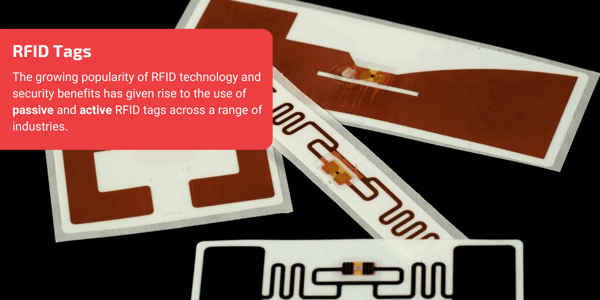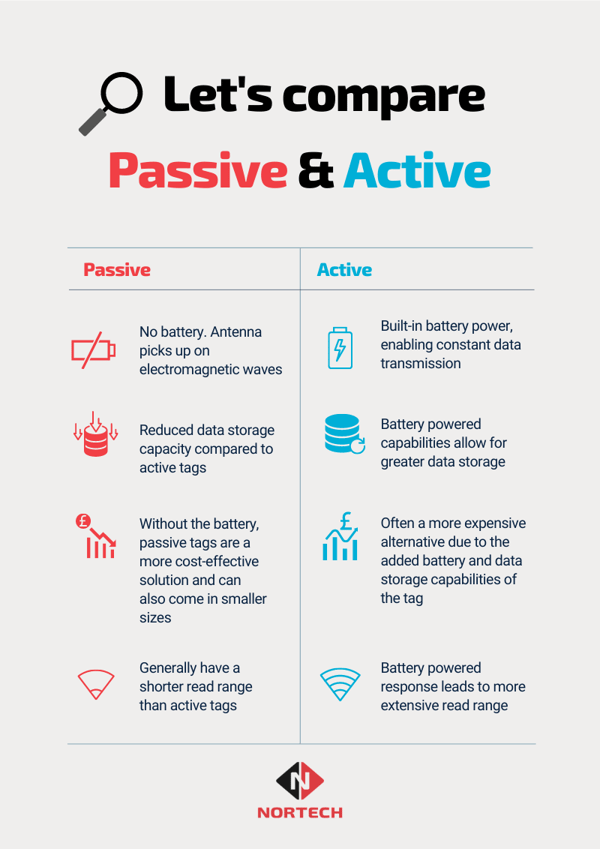The growing popularity of Radio Frequency Identification (RFID) technology and the security benefits it brings has given rise to the use of RFID tags across a range of industries.
The majority of RFID systems consist of a microchip with an antenna (tag), a long-range reader with an antenna and an access control server.
Selecting the right tag for your security system is not easy – there are endless options available on the market and choosing the right option for your individual needs can be tricky.
With this in mind, we decided to put together this quick guide that covers:
- How RFID tags work and the technology behind them
- The difference between active and passive RFID tags
- The different RFID tag types and when to use them
How RFID Tags Work
RFID tags’ essence could be boiled down to three key elements: a microchip, antenna and a substrate. The microchip within the tag is what stores and processes information, modulates and demodulates radio-frequency signals. And antenna enables the tag to receive and transmit the signal.
Read Our Report: Key Technologies Shaping Vehicle Access Control (2021 Update)
RFID tags can be differentiated by their power supply. There are two main types of tags used in the access control industry - passive and active tags.

Passive Vs. Active Tags
A passive RFID tag doesn’t include a battery; therefore, its’ built-in antenna picks up on the electromagnetic waves that are sent out by the reader.
These tags tend to be less expensive compared to active tags, and therefore could be a cost-effective solution for companies with a tight budget. They are also smaller in size as they don’t need to carry a battery.
However, they also have their limitations. As passive tags don’t have a power source of their own, they require extra time for charging before conducting any data transmission. They also tend to have fewer data storage capacity compared to active tags.
Active RFID tags have a built-in battery power allowing it to transmit the data stored on to it directly to the reader continuously.
Even though their batteries do have a limited lifetime, it usually does last for years. Tag's battery-powered response makes it a perfect solution for applications where RF signals might encounter interference. Security professionals can also use these tags to track the real-time location of the objects.
Another benefit of active tags is their extensive reading range, which makes them valuable in automatic vehicle identification and access. However, all these additional features come at a price - active tags tend to be more expensive than passive tags.

Key RFID Tag Types
RFID tags come in different shapes, sizes and materials. Understanding different RFID tag types will enable you to choose the right option for your unique environment. Below are the key tag types commonly used as part of an automatic vehicle identification system.
Windshield Tags (Interior Stickers)
Windscreen Tags usually come in the form of a sticker that you can apply to the vehicle's windscreen from the inside. It is a passive tag and as such does not contain a battery. Windscreen tags are a cost-effective solution for applications such as parking - perfect for upgrading existing proximity parking access control systems.
Read More: What is RFID Access Control And How Does It Work?
It's completely maintenance-free and is very easy to install. Once applied, the thin, flexible sticker format is permanently attached to the windscreen, offering a tamper-resistant automatic vehicle identification solution.
For added security, companies can also request tamper-resistant windscreen tags that will show visual proof of removal and are difficult to remove intact and functional.
Therefore, it’s a great way to prevent vehicle theft and other security concerns common in applications such as parking.
Headlight Tags (Exterior Stickers)
In situations where vehicle windscreens are fully metallised, a passive exterior tag will do the trick. It is usually best applied to a non-metallic part of the vehicle, such as the headlights.
They are made from a transparent material and are completely adhesive. As with windshield tags, headlight tags are tamper-resistant and show proof of removal, as they are extremely hard to remove intact and functional. The chip inside is also protected against harmful UV rays.
Heavy-duty Tags
Its’ name is inspired by its design – rugged and durable. It’s a perfect solution for long term outdoor use in industrial environments, where the tag needs to be mounted onto the exterior of the vehicle.
Its housing is waterproof, shock and impact resistant, with excellent stability over fluctuating temperatures.
Applications such as secured vehicle access in vehicle logistics, industrial operations, automated truck activities and parking access would greatly benefit from this type of tag. This tag can also be tied or bolted onto bicycles, forklifts and many other industrial devices.
Combi Cards (Combined Technologies)
Combi cards are a great option if you need a two-in-one solution. These cards utilise long-range RFID and proximity or smartcard technology, enabling them to be used for both vehicle and building access control. This combination enables compatibility and seamless integration with existing access control applications.
As you can see from the key examples above, RFID tags for vehicle access come in many shapes and forms – all with a whole set of advantages specially designed to suit your specific needs.
They are an indispensable feature of a truly automated vehicle identification (AVI) system.
If you would like to learn more about the key components of AVI, check out our Automatic Vehicle Identification Guide.

